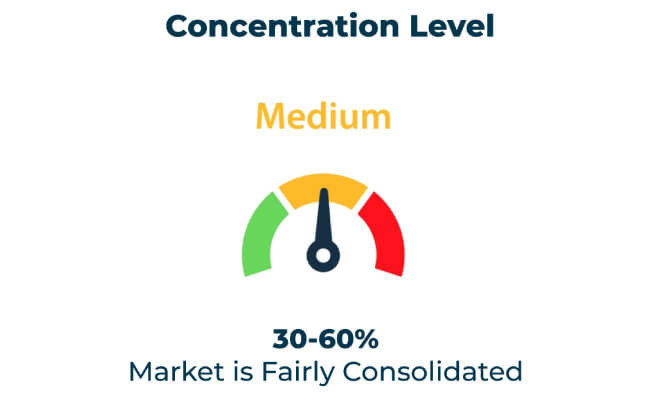Manufacturers in the label applicators market drive growth through efficient, high-speed, and reliable labeling solutions. Advanced technologies are applied in the label applicators market for food and beverages, pharmaceuticals, logistics, and retail. The global label applicators market will exceed USD 9180.6 million by 2035 with a compound annual growth rate (CAGR) of 4.3%. Companies are focused on automation, sustainability, and precision to meet the needs of evolving consumers and industries.
The market expands because industries adopt automated solutions to increase the accuracy and efficiency of labeling. Manufacturers combine IoT and AI in their systems to enhance functionality and customization. They collaborate with key sectors in ensuring compliance with regulatory and operational standards.
| Attribute | Details |
|---|---|
| Projected Value by 2035 | USD 9180.6 million |
| CAGR (2025 to 2035) | 4.3% |
Factors Driving Market Growth
| Category | Market Share (%) |
|---|---|
| Top 3 Players (Avery Dennison, Weber Packaging, ProMach) | 15% |
| Rest of Top 5 Players (Label-Aire, Quadrel Labeling) | 09% |
| Next 5 of Top 10 Players | 07% |
Type of Player & Industry Share
| Type of Player | Market Share (%) |
|---|---|
| Top 10 Players | 31% |
| Next 20 Players | 40% |
| Remaining Players | 29% |

Emerging markets in Asia-Pacific, Africa, and Latin America offer vast export opportunities. Industrialization, regulatory compliance, and expansion of the e-commerce industry have increased the demand for reliable and automated labeling systems. The governments encourage automation and smart manufacturing, providing more scope for exporters.
| Region | North America |
|---|---|
| Market Share (%) | 35% |
| Key Drivers | Drives automation and smart labeling technologies. |
| Region | Europe |
|---|---|
| Market Share (%) | 30% |
| Key Drivers | Promotes sustainable practices and compliance. |
| Region | Asia-Pacific |
|---|---|
| Market Share (%) | 25% |
| Key Drivers | Experiences growth in e-commerce and industrial labeling. |
| Region | Other Regions |
|---|---|
| Market Share (%) | 10% |
| Key Drivers | Demands affordable and efficient labeling solutions. |
The label applicators market is witnessing steady growth through automation, sustainability, and technological innovations in the trends of the industry. Companies concentrating on smart technologies, eco-friendly practices, and expansions into emerging markets are strengthening their positions in the competition. Industry 4.0 technologies integrated will enhance efficiency and precision, moving the market forward.
| Tier | Key Companies |
|---|---|
| Tier 1 | Avery Dennison, Weber Packaging Solutions, ProMach |
| Tier 2 | Label-Aire, Quadrel Labeling |
| Tier 3 | EPI Labelers, ALTech |
The label applicators market grows steadily as automation, sustainability, and technological innovation shape industry trends. Companies that focus on smart technologies, eco-friendly practices, and emerging market expansion strengthen their competitive positions. Integration of Industry 4.0 technologies enhances efficiency and precision, driving the market forward.
Key Definitions
Abbreviations
Methodology
This report integrates primary research, secondary data, and expert insights. Analysts validated findings through interviews with industry professionals and end-users. The methodology ensures a comprehensive and accurate market perspective.
This market is essentially concerned with the development and manufacture of machines intended to apply labels to products, packaging, and containers. Such solutions bring improved accuracy, efficiency, and adherence in food and beverages, pharmaceutical industries, and logistics.
The market is expected to grow at a 4.3% CAGR, reaching USD 9180.6 million by 2035.
Key industries include food & beverage, pharmaceuticals, logistics, and manufacturing.
Automation, sustainability, modular designs, and the integration of AI-powered systems are the dominant trends.
Top companies include HERMA, Weber Packaging, and ProMach, holding 35% of the market share.
Sustainability is critical, with companies focusing on recyclable materials, energy-efficient systems, and minimizing material waste.
Regions like Asia-Pacific, Africa, and Latin America offer growth potential due to industrial expansion and increasing e-commerce activity.
Many applicators now include AI, smart sensors, and real-time tracking capabilities to optimize efficiency and ensure precision.






Full Research Suite comprises of:
Market outlook & trends analysis
Interviews & case studies
Strategic recommendations
Vendor profiles & capabilities analysis
5-year forecasts
8 regions and 60+ country-level data splits
Market segment data splits
12 months of continuous data updates
DELIVERED AS:
PDF EXCEL ONLINE
Labels Market Forecast and Outlook 2025 to 2035
Labeling and Coding Equipment Market Size and Share Forecast Outlook 2025 to 2035
Labels, Tapes And Films Market Size and Share Forecast Outlook 2025 to 2035
Labeling Equipment Market Analysis - Size, Share, and Forecast Outlook 2025 to 2035
Label Printers Market Size, Growth, and Forecast 2025 to 2035
Labelling Machine Market Growth & Industry Trends through 2035
Labeling Software Market Growth - Trends & Forecast through 2034
Label Printing Software Market – Smart Labeling & Automation
Competitive Overview of Labels Companies
Competitive Breakdown of Labeling Equipment Providers
Label Applicators Market Size and Share Forecast Outlook 2025 to 2035
GHS Label Market Size and Share Forecast Outlook 2025 to 2035
USA Labels Market Size and Share Forecast Outlook 2025 to 2035
GMO Labelling Market Size and Share Forecast Outlook 2025 to 2035
Top Labelling Equipment Market Trends - Growth & Forecast 2025 to 2035
Leading Providers & Market Share in GHS Label Industry
Market Share Distribution Among USA Labels Providers
Foam Labels Market Trends and Growth 2035
Foil Labels Market Analysis by Metal Foils & Polymer-Based Foils Through 2035
Void Label Market Trends & Industry Growth Forecast 2024-2034

Thank you!
You will receive an email from our Business Development Manager. Please be sure to check your SPAM/JUNK folder too.
Chat With
MaRIA